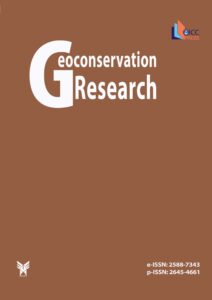New Mineral Discovery Geosites: Valuing for Geoconservation Purposes
Authors
Abstract
Discovery of new minerals contributes substantially to geoscience development. Localities where such discoveries have been made appear to be unique, and they deserve recognition as new mineral discovery geological heritage sites (NMD geosites). Valuing the latter is a complex procedure. Generally, it appears sensible to accept that NMD geosites are of national importance by definition. Finding several new minerals in one locality (multi-NMD geosite) increases geosite rank from national to global (examples can be found in northwest Iran and southwest Russia). The ‘spirit of novelty’ is essential characteristic of NMD geosites, and this helps to attract visitors. Because of permanent changes in the mineralogical knowledge, validity of some minerals can be later disproved. For such cases, the category of historical NMD geosites can be applied. Recognition of NMD geosites is the only first, but important step in their protection from various damages (related to mining and uncontrolled sample collecting).
Read the full text of the articleKeywords
References
- Black G.P (1985). Geological conservation and the Nature Conservation Council. Geological Curator 4:217-220.
- Bradbury J (2014). A keyed classification of natural geodiversity for land management and nature conservation purposes. Proceedings of the Geologists' Association 125:329-349.
- Brilha J (2016). Inventory and quantitative assessment of geosites and geodiversity sites: a review. Geoheritage 8:119-134.
- Brocx M & Semeniuk V (2010). The geoheritage significance of crystals. Geology Today 26:216-225.
- Cairncross B (2011). The National Heritage Resource Act (1999): Can legislation protect South Africa's rare geoheritage resources? Resources Policy 36:204-213.
- Erikstad E (2013). Geoheritage and geodiversity management - the questions for tomorrow. Proceedings of the Geologists' Association 124:713-719.
- Galuskin E.V, Lazić B, Armbruster T, Galuskina I.O, Pertsev N.N, Gazeev V.M, Wlodyka R, Dulski M, Dzierzanowski P, Zadov A.E & Dubrovinsky L.S (2012). Edgrewite Ca9(SiO4)4F2-hydroxyledgrewite Ca9(SiO4)4(OH)2, a new series of calcium humite-group minerals from altered xenoliths in the ignimbrite of Upper Chegem caldera, Northern Caucasus, Kabardino-Balkaria, Russia. American Mineralogist 97:1998-2006.
- Galuskina I.O, Kruger B, Galuskin E.V, Armbruster T, Gazeev V.M, Wlodyka R, Dulski M & Dzierzanowski P (2015). Fluorchegemite, Ca7(SiO4)3F2, a new mineral from the edgrewite-bearing endoskarn zone of an altered xenolith in ignimbrites from upper Chegem Caldera, Northern Caucasus, Kabardino-Balkaria, Russia: Occurrence, crystal structure, and new data on the mineral assemblages. Canadian Mineralogist 53:325-344.
- Gray M (2013). Geodiversity. Valuing and Conserving Abiotic Nature. Chichester: Wiley-Blackwell.
- Hatipoglu M (2010). Gem-Quality diaspore crystals as an important element of the geoheritage of Turkey. Geoheritage 2:1-13.
- Henriques M.H & Brilha J (2017). UNESCO Global Geoparks: a strategy towards global understanding and sustainability. Episodes 40:349-355.
- Henriques M.H, Pena dos Reis R, Brilha J & Mota T (2011). Geoconservation as an Emerging Geoscience. Geoheritage 3:117-128.
- Kirillova K, Fu X, Lehto X & Cai L (2014). What makes a destination beautiful? Dimensions of tourist aesthetic judgment. Tourism Management 42:282-293.
- Makovicky E, Topa D, Tajeddin H, Putz H & Zagler G (2013). Ferdowsiite: A new mineral from the Barika ore deposit, Iran. Canadian Mineralogist 51:727-734.
- Pasero M, Kampf A.R, Ferraris C, Pekov I.V, Rakovan J & White T.J (2010). Nomenclature of the apatite supergroup minerals. European Journal of Mineralogy 22:163-179.
- Prosser C.D (2013). Our rich and varied geoconservation portfolio: the foundation for the future. Proceedings of the Geologists' Association 124:568-580.
- Prosser C, Murphy M & Larwood J (2006). Geological conservation: a guide to good practice. Peterborough: English Nature.
- Reynard E & Brilha J (2017). Geoheritage: Assessment, Protection, and Management. Amsterdam: Elsevier.
- Rolfo F, Benna P, Cadoppi P, Castelli D, Favero-Longo S.E., Giardino M, Balestro G, Belluso E, Borghi A, Camara F, Compagnoni R, Ferrando S, Festa A, Forno M.G, Giacometti F, Gianotti F, Groppo C, Lombardo B, Mosca P, Perrone G, Piervittori R, Rebay G & Rossetti P (2015). The Monviso Massif and the Cottian Alps as symbols of the Alpine chain and geological heritage in Piemonte, Italy. Geoheritage 7:65-84.
- Ruban D.A (2010). Quantification of geodiversity and its loss. Proceedings of the Geologists' Association 121:326-333.
- Ruban D.A (2017). Geodiversity as a precious national resource: A note on the role of geoparks. Resources Policy 53:103-108.
- Ruban D.A & Kuo I (2010). Essentials of geological heritage site (geosite) management: a conceptual assessment of interests and conflicts. Natura Nascosta 41:16-31.
- Serrano E & Ruiz-Flano P (2007). Geodiversity. A theoretical and applied concept. Geographica Helvetica 62:140-147.
- Thomas M.F (2016). New keywords in the geosciences - some conceptual and scientific issues. Revista do Instituto Geologico, Sao Paolo 37:1-12.
- Topa D, Makovicky E, Tajedin H, Putz H & Zagler G (2013). Barikaite, Pb10Ag3(Sb8As11)Σ19S40, a new member of the sartorite homologous series. Mineralogical Magazine 77:3039-3046.
- Wimbledon W.A.P (1996). Geosites - a new conservation initiative. Episodes 19:87-88.
- Wimbledon W.A.P & Smith-Meyer S (Eds) (2012). Geoheritage in Europe and its conservation. Oslo: ProGEO.




